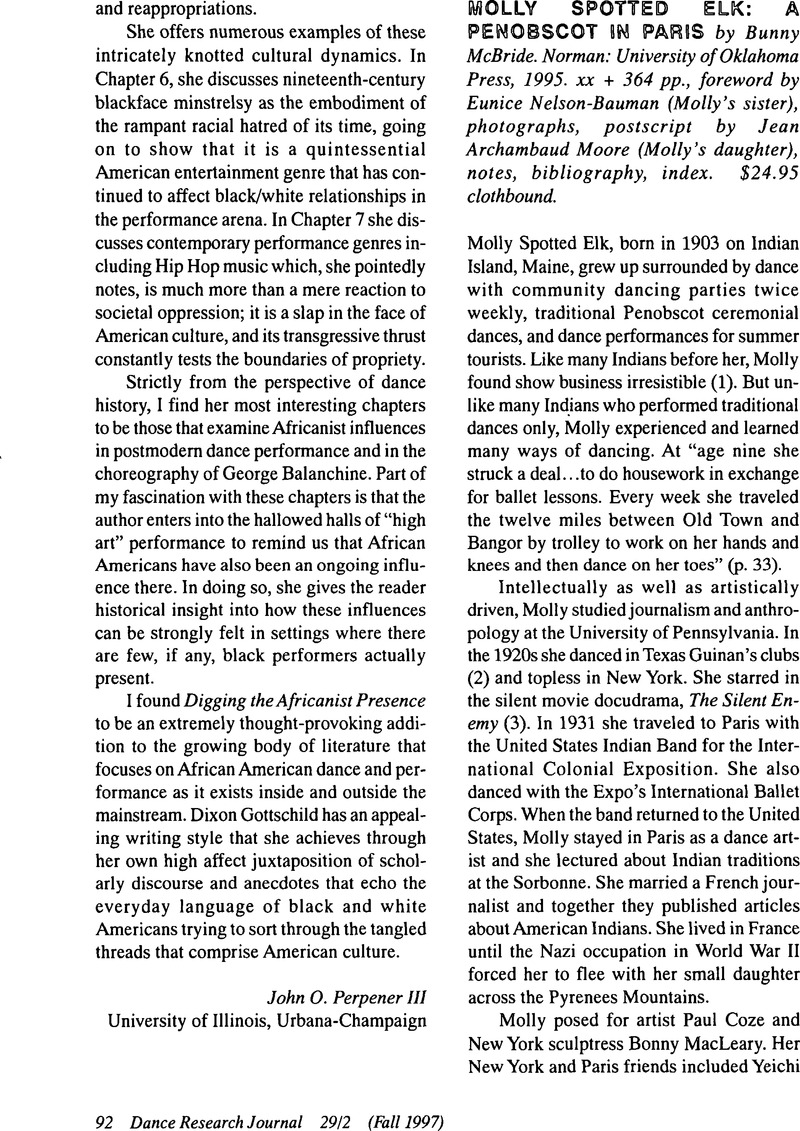No CrossRef data available.
Article contents
Molly Spotted Elk: A Penobscot in Paris, by Bunny McBride. Norman: University of Oklahoma Press, 1995. xx + 364 pp., foreword by Eunice Nelson-Bauman (Molly's sister), photographs, postscript by Jean Archambaud Moore (Molly's daughter), notes, bibliography, index. $24.95 clothbound.
Published online by Cambridge University Press: 22 July 2014
Abstract

- Type
- Reviews
- Information
- Copyright
- Copyright © Congress on Research in Dance 1997
References
NOTES
1. The long tradition of American Indians in show business is explored in Prins, Harald E. L. and McBride, Bunny, “Discovering Europe 1493,” World Monitor, November 1992, 58–62.Google Scholar
2. Andrist, Ralph K., ed., The American Heritage History of the 20's & 30's (New York: American Heritage Publishing Company, 1970), 108, 170–171.Google Scholar
3. The Silent Enemy is cited in Weatherford, Elizabeth, ed., Native Americans on Film and Video (New York: Museum of the American Indian/Heye Foundation, 1981), 103–104.Google Scholar
4. See entries on Nimura, Yeichi and Kay, Lisan in Chujoy, Anatole and Manchester, P. W., eds., The Dance Encyclopedia (New York: Simon and Schuster, 1967).Google Scholar
5. After reading Molly Spotted Elk: A Penobscot in Paris, I corresponded with author McBride who sent two publications. The first (from which this quotation is drawn, p. 415) reflects on her research for Molly's, biography, “The Spider and the WASP: Chronicling the Life of Molly Spotted Elk” in Reading Beyond Words: Context for Native History, eds. Brown, Jennifer S. H. and Vibert, Elizabeth (Peterborough, Ontario: Broadview Press, 1996): 403–427.Google Scholar The second was in response to my query about her own dancing experience. “Dancing in the Desert,” The Christian Science Monitor, 7 January 1987 (p. 27) humorously recounts her experience of dancing with Tuareg women in Mali during her research about Saharan nomads who had survived a long drought.
6. Kurath, Gertrude Prokosch, “An Analysis of The Iroquois Eagle Dance and Songs,” in The Iroquois Eagle Dance: An Offshoot of the Calumet Dance, by Fenton, William N., Bureau of American Ethnology Bulletin 156 (Washington, D.C.: Smithsonian Institution, 1953): 223–306.Google Scholar


